June 2017, Vol. 244, No. 6
TechNotes
Case Study: Mexssub Repairs Leaking, Bent Pipeline in Gulf of Mexico

A leading oil and gas company engaged the Mexssub team in commercial discussions in May 2012. The company wanted to restore the mechanical integrity of a pipeline in the Gulf of Mexico. A leak in the 30-inch horizontal pipeline occurred and initially the operator installed a temporary mechanical clamp.
A few months later, a ship’s anchor dragged across the pipeline, causing a significant bend to the line where the leak originally occurred. As a result of this second crisis, the operator was forced to consider a costly shutdown of the pipeline during repair. Recognizing the possible magnitude of this action, the operator engaged the Mexssub team to engineer the industry’s leading Det Norske Veritas (DNV)-certified permanent repair. The nature of the damage required the Mexssub engineering team to devise specialized solutions that have become perfected and since used on other projects.
“First, we had to design and manufacture a sleeve that would encompass the line and the existing mechanical clamp and fit the bent line,” said Alfredo Morales, of Mexssub. “Next, we had to design and manufacture a habitat that addressed two points of bending by creating an asymmetrical habitat, a very complex design.”
Workers executed the repair on a bent line, which was recreated through design software in order to experiment with solution alternatives and approaches. Mexssub designed and engineered a customized solution using its Sleeve System and Habitat System, repairing the point of bending in the pipeline while protecting the vulnerable leak section by welding the sleeve into place.
Traditionally, an operator facing this challenge would shut down or significantly reduce full production for several weeks during such a complex repair procedure. “That would have required funding an extremely expensive operation, as well as shutting down full production of the line for several weeks,” Morales said.
The client, however, sought a permanent repair without suspending production, to be done urgently within a constrained timeframe and executed at the highest operational and safety standards.
Approach
Understanding the root causes of the pipeline failure was critical to the team. By working within a series of parameters, Mexssub determined the appropriate type of solution to be implemented. The process begins with a thorough inspection from which a design and execution plan are crafted. Mexssub first assessed the pipeline material, product, pressure, temperature, and general nature of the anomaly.
Then, after a detailed risk analysis, Mexssub designed a three-point plan of action:
- Design and manufacture a quality sleeve to protect the pipeline and its existing mechanical clamp, permanently restoring the line’s mechanical integrity.
- Design and manufacture an asymmetrical habitat built to fit the point of bending.
- Execute the repair with minimal margin of error, ensuring a perfect fit of both systems and minimizing all operational risks.
“The client responded favorably to our suggested course of action, trusting in our analytical and technical abilities,” said Morales. “The operator was deeply involved during the risk analysis and saw the scientific data and reasoning behind all decisions.”
After the plan was approved by the client, Mexssub began its project execution, revisiting and adapting its risk analysis on a continuous basis.
“The inspection explores many factors, such as the wall thickness at the points where the Sleeve System will be welded into place,” Morales said. “We implemented a measurement device that clamps a series of interconnected rings along the pipeline or riser to precisely calculate any points of curvature and bending.”
After an in-depth field analysis, the sleeve was designed to abide by all necessary procedural norms, ultimately providing a DNV-certified permanent solution. All the designs were stress-tested based on the environment.
Result
The pipeline’s integrity was fully and permanently restored while maintaining uninterrupted production. The Mexssub team delivered the results within the established time frame and budget.
Mexssub conducted the manufacturing and DNV certification process from Sept. 14-Nov 4, 2012. Then, research, analysis and repair preparation took 15 months, allowing repairs to begin Feb. 10, 2013 and conclude March 17, 2013.
“All operators have inspection campaigns scheduled periodically to review the integrity of the risers and pipelines,” Morales said. “In this case, the operator had already detected a compromised mechanical integrity. Mexssub collected information from the inspection campaign and worked off the pipeline and mechanical clamp design blueprints, and then recreated it all through software for spot-on accuracy.”
Throughout the project, Mexssub found its measuring equipment for bends reliable and consequently, a crucial tool during the inspection phase. The team also improved the process for designing and manufacturing an asymmetrical habitat, including establishing a process to address stresses created by the design. The client benefited from a permanent repair, a safe and reliable execution, and continuous production throughout the process.
“The mechanical integrity of the pipeline was fully restored permanently,” said Morales. “The repair was executed on time, on budget and within the timeframe desired by the client while the pipeline continued safe production.”
Author: Franco Silva is business development manager for Mexssub. He holds a degree in psychology and entrepreneurship from Tufts University.





Comments